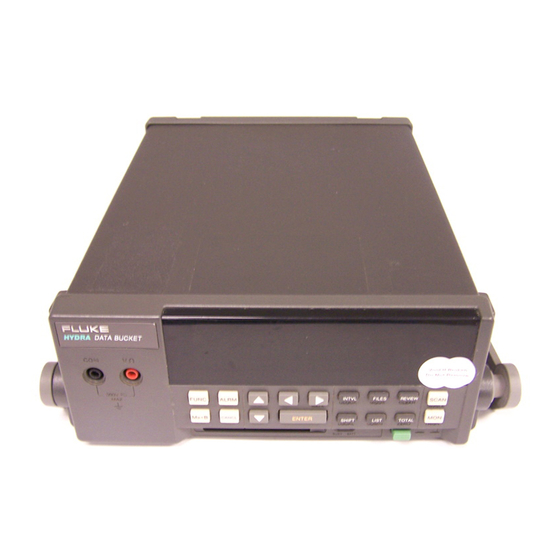
Summarization of Contents
Chapter 1 Preparation for Use
Introduction
Provides an overview of the 2635A Hydra Series II Data Bucket and its capabilities.
Operating Modes
Outlines the five primary modes of operation for the Data Bucket.
Front Panel Operation
Details how to configure channels and perform basic multimeter operations using the front panel.
Memory Card Operation
Explains how to use the memory card for saving setup and recording data.
Measurement Capabilities
Details the electrical and physical parameters the Data Bucket can measure.
Setting Up the Instrument
Covers unpacking, inspecting, and connecting the instrument for initial use.
Chapter 2 Front Panel Operations
Summary of Front Panel Operations
Provides a procedural overview of front panel operations and control diagrams.
Configuring the Instrument for Operation
Details how to power on the instrument and select basic operational settings.
Configuring a Measurement Channel
Guides users through setting up channels for various measurement types.
Setting Operating Conditions
Explains how to set scan interval, measurement rate, alarms, and Mx+B scaling.
Operating Modes
Describes how to use the Scan, Monitor, and Review modes of operation.
Chapter 3 Memory Card Operations
Summary of Memory Card Operations
Introduces memory card usage for saving setup and recording data.
Inserting and Removing the Memory Card
Provides instructions on handling the memory card, including changing it during scanning.
Setup File Procedures
Explains how to store, load, and erase instrument configuration (setup) files.
Data File Procedures
Details how to open and erase measurement data files on the memory card.
Chapter 4 Computer Operations
Summary of Computer Operations
Overviews PC control, configuration, and data exchange with the instrument.
Connecting the Instrument to a PC
Illustrates common configurations for connecting the instrument to a PC via RS-232.
Configuring the Instrument for Computer Operations
Guides setting RS-232 parameters like baud rate, parity, CTS, and echo.
Testing the Instrument/PC RS-232 Interface
Provides procedures for testing the RS-232 link using terminal emulation and BASIC.
Computer Interface Commands and Operation
Explains how the instrument processes commands and outputs data via the computer interface.
Chapter 5 Printer Operations
Summary of Printer Operations
Outlines using an RS-232 connection to print measurement results and memory card directories.
Connecting the Instrument to a Printer
Shows common configurations for connecting the instrument to a printer.
Configuring for Printer Operations
Guides setting RS-232 parameters (baud rate, parity, CTS) for printer communication.
Printing Measurement Data and Memory Card Directory
Describes printing measurement results, review array, and memory card directory.
Chapter 6 Modem Operations
Summary of Modem Operations
Explains modem operations via RS-232 and telephone lines for remote applications.
Connecting the Modem to a PC for Configuration
Details connecting a modem to a PC for configuration using terminal emulation.
Configuring the Instrument for Modem Operations
Guides setting RS-232/modem link parameters like baud rate, parity, CTS, and echo.
Chapter 7 Maintenance
Introduction
Describes basic maintenance tasks the user can perform.
Selftest Diagnostics and Error Codes
Details the selftest routine and lists power-up error codes and their meanings.
Performance Tests
Outlines procedures for verifying instrument performance and accuracy.
RTD Temperature Accuracy Test
Guides testing RTD temperature accuracy using resistance sources or RTDs.
Digital Input/Output Verification Tests
Covers verification tests for digital output and digital input lines.
Calibration
Refers to the service manual for calibration procedures and conditions.
Appendix A Specifications
DC Voltage Measurements
Provides resolution and accuracy specifications for DC voltage measurements.
AC Voltage Inputs
Details resolution, accuracy, and impedance for AC voltage measurements.
Temperature Measurements (Thermocouples)
Lists accuracy specifications for various thermocouple types.
RS-232-C
Specifies RS-232 connector type, signals, baud rates, data format, flow control, and echo.
Appendix B Crosstalk Considerations
Introduction
Augments discussion of AC signal effects on other channels, providing references for analysis.
AC Signal Cross Talk in a DC Voltage Channel
Quantifies AC signal crosstalk effects on DC voltage measurement channels.
AC Signal Cross Talk into an AC Voltage Channel
Details AC signal crosstalk effects on AC voltage measurement channels.
Appendix C Binary Upload of Logged Data
Introduction
Introduces the LOG_BIN? query for uploading logged data and its conversion process.
Decoding the ASCII String
Explains how to decode the ASCII string response into binary data.
Appendix D RS-232 Cabling
Introduction
Details RS-232 cabling for connecting instruments to PCs, printers, or modems.
Connections
Summarizes cable requirements and typical connection diagrams for RS-232.
Appendix F Memory Card File Formats
Introduction
Describes the format of binary files created by the 2635A Data Bucket for scan data.
Data File Format
Details the two-part format of data files (header and scan data).
Setup File Format
Explains the format of setup files used for instrument configurations.
Appendix G True RMS Measurements
Introduction
Explains how the instrument measures true RMS values of AC voltages.
Waveform Comparison (True RMS VS Average Responding)
Compares true RMS measurements with average-responding devices for common waveforms.











Need help?
Do you have a question about the 2635A and is the answer not in the manual?
Questions and answers